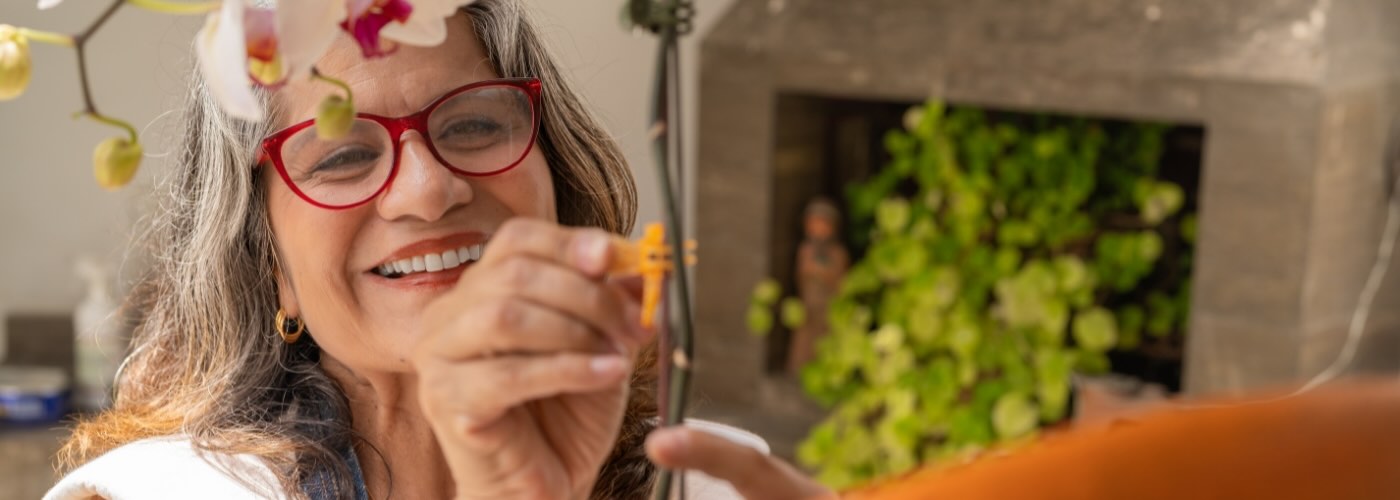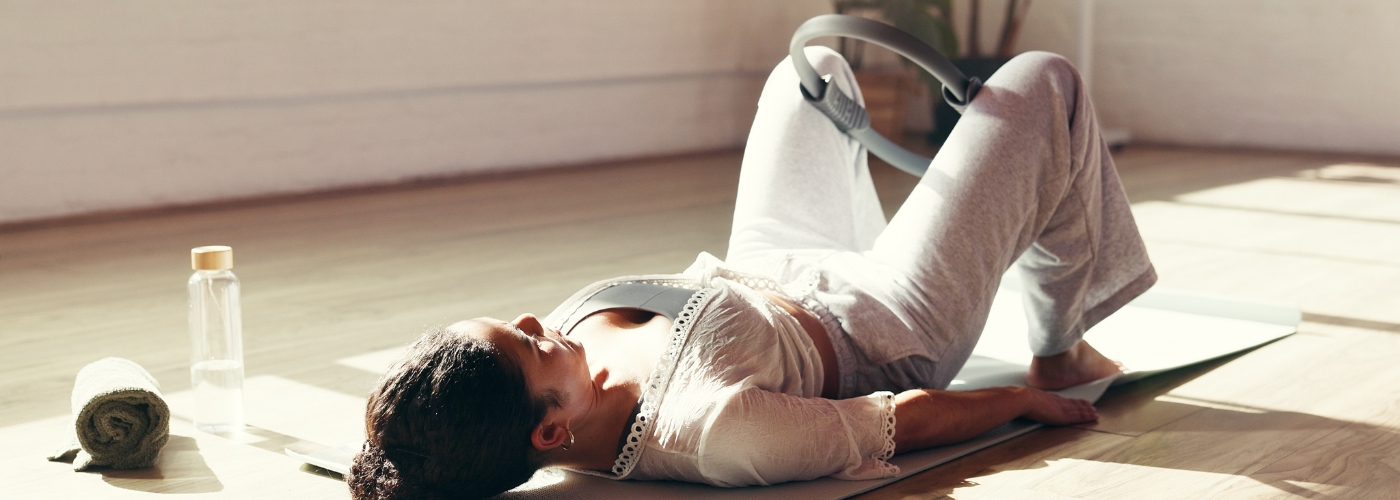
As estrogen declines, it feels as though our bodies have betrayed us. Vaginal dryness creeps in slowly, and before we know it, our body feels different. Intimacy changes. Our pleasure center feels as though an indefinite hiatus has occurred. It’s common, it’s uncomfortable, and it’s under-discussed.
Over 50% of postmenopausal women experience dryness and discomfort, while nearly 20% of premenopausal women report similar symptoms: painful intercourse, burning, itching, and irritation.¹ They all stem from a decrease in natural moisture. Estrogen decline is a typical culprit, whether due to menopause, postpartum recovery, or medications like hormonal contraceptives. But other contributors include stress, low hydration, reduced blood flow, harsh soaps, and microbiome imbalance.
Vaginal dryness doesn’t have to be a life sentence or an inevitable part of aging. The body has signaled that the balance has shifted, and with the right approach, that balance can be restored.
Dual Action
The World Health Organization (WHO) defines sexual health as “a state of physical, emotional, mental, and social well-being in relation to sexuality” – not merely the absence of disease or dysfunction.² And natural lubrication? Well, a woman’s sexual health is dependent upon it – at least in part.
Healthy vaginal secretions are a finely tuned biological response with the dual role of protection and pleasure. The naturally lubricating microenvironment of the vagina keeps tissues supple, maintains an acidic pH, protects the vaginal wall from microtears during intercourse, and creates an inherent barrier against uninvited microorganisms.
These secretions, produced by glands near the vaginal opening and cervical mucosa, contain proteins, immune factors, and antimicrobial peptides released by vaginal epithelial cells. These fluids are part of a larger defense network typically dominated by beneficial Lactobacillus species, which produce lactic acid to help maintain low vaginal pH (acidic) and protect against harmful pathogens, including sexually transmitted infections (STIs).³
A loss of natural lubrication can disrupt the balance and shift the microbial environment toward dysbiosis (microbiome imbalance). The resulting changes in dominant microbial species can then cause the mucosal barrier to weaken, further hindering the ability to lubricate properly. This creates a two-way cyclical process between dysbiosis and vaginal dryness – one informs the other.
Damaged or dehydrated tissues cause discomfort, but it also increases susceptibility to non-sexually transmitted infections, predisposing individuals to bacterial vaginosis (BV), urinary tract infections, and recurrent yeast infections.⁴
Quick Fixes
A commercial vaginal lubricant or moisturizer is usually the initial go-to when dryness starts showing up. They’re widely available and can provide instant comfort, making intimacy much more enjoyable in the moment. No harm in that, right?
Let’s chat that out.
Distinction number one: Your vaginal pH and microbiome are unique. When you introduce a foreign substance to that environment, you run the risk of altering your natural chemistry and the bacteria that depend on it. The delicate vaginal ecosystem can become imbalanced and decline further into a less-than-optimal pH.
That’s because Lactobacillus bacteria help maintain the acidic pH (around 3.8-4.5) that supports mucosal moisture and prevents bacterial overgrowth. Products with neutral or alkaline pH (above 7) can tip that microbial balance toward dryness and irritation. In the moment, store-bought lubricants seem to work; over the long haul, they can compound the problem.
Distinction number 2: Lubricants are designed for temporary relief during intercourse, while moisturizers are meant for regular use to maintain hydration and improve daily comfort. One helps in the moment; the other supports ongoing vaginal hydration. Long-term use of either one, depending on the quality and ingredients, can make the situation worse. Studies have shown that many over-the-counter lubricants and moisturizers have harmful pH levels or high osmolality, which can actually pull moisture out of vaginal cells and cause irritation.⁵
Osmolality refers to the concentration of solutes (like sugars, salts, and glycols) in a product. When a lubricant’s osmolality is higher than that of vaginal tissue, it draws water out of the cells instead of hydrating them, leaving the tissue dry and more prone to microtears. The WHO suggests a pH of 4.5 and an osmolality below 1200 mOsm/kg; you’d be surprised at how off-target many well-known brands are.⁶ Choosing a product that matches physiological exchange rates supports hydration rather than obstructing it, maintaining cellular integrity.
Distinction number 3: Not all lubricants and moisturizers are created equal. Some commercial products contain ingredients like parabens, glycerin, chlorhexidine gluconate (CHG), or nonoxynol-9, all of which can disrupt the vaginal microbiome and damage protective Lactobacillus species.⁷ Choosing biocompatible, pH-balanced products preserves microbial harmony and prevents further dryness or sensitivity. Even occasional use doesn’t excuse poor ingredients – what you put in your body, even “down there,” deserves your attention.
Even the best product is a temporary fix. True restoration addresses the underlying cause.
Long-Lasting Rejuvenation
Unlike lubricants, which simply add moisture, vaginal rejuvenation is a regenerative therapy that reawakens the body’s natural ability to lubricate, heal, and respond to intimacy. Modern rejuvenation techniques are non-surgical, well-tolerated, and clinically proven to enhance vaginal tissue health through gentle stimulation of collagen, elastin, and blood flow using radio frequency (RF) or laser technology.
Instead of repeatedly masking dryness with external products, rejuvenation treatments address the underlying tissue health that makes lubrication possible in the first place. Researchers summed it up beautifully: “In the hands of well-trained physicians, energy-based devices are likely to benefit millions of women by aiding them in reclaiming, relishing, and reveling in their femininity at full capacity.”⁸
Clinical experience and emerging studies suggest that RF-based rejuvenation can restore the structural and microbial balance necessary for improved elasticity, mucosal thickness, and resulting vaginal moisture for more satisfying sexual experiences.⁹
Three popular technologies that we employ at Aayla include:
- FormaV Uses controlled radiofrequency (RF) energy to gently heat the vaginal tissue, stimulating collagen remodeling and increasing local circulation. The result is improved elasticity, hydration, and a return to a healthy pH balance.
- Morpheus8V Combines microneedling with fractional RF to target deeper tissue layers. This dual action promotes collagen and elastin synthesis, improving sensitivity, tone, and natural lubrication.
- VTone Strengthens the pelvic floor and enhances neuromuscular control, improving urinary continence and sexual satisfaction, with a gentle electrical muscle stimulation (EMS) device.
Most treatments take 20 to 60 minutes, require little to no downtime, and produce cumulative results over several sessions. Many patients report relief, increased moisture, regained intimacy, and more pleasant sensations after the first treatment, with even further improvement over the following weeks.
Lubricants have their place, in both personal and clinical settings. The goal of rejuvenation is not to forbid lubricants but to reduce dependence on them for everyday dryness.
If you feel like you need a boost, be sure you’re checking the label for:
- pH-balance (3.5-4.5)
- Low osmolality (under 1,200 mOsm/kg)
- Gentle, fragrance-free, and biocompatible
- Natural humectants like aloe vera or hyaluronic acid
- Free of parabens, CHG, and nonoxynol-9
Some of the best options include high-quality hyaluronic acid-based moisturizers and aloe vera gels, which hydrate without altering vaginal chemistry. These formulas can complement the rejuvenation process by reinforcing tissue hydration as your body’s natural lubrication continues to improve.
Ahhh, Balance
As the vaginal environment becomes healthier, most women notice they no longer need daily moisturizers or lubricants to stay comfortable or enjoy sex. Instead of repeatedly masking dryness with external products, the body’s natural processes are reminded how to function again.
Given the WHO definition of sexual wellness and the availability of supportive therapies, there is no reason to let your sexual fire dampen. If you’re tired of struggling with the discomfort or simply want to explore the next level of intimate health, Aayla Sexual Wellness and Aesthetics can help you return to the natural flow and rhythm of what nature intended – a state of balance.
References:
- Potter, N., & Panay, N. (2021). Vaginal lubricants and moisturizers: a review into use, efficacy, and safety. Climacteric : the journal of the International Menopause Society, 24(1), 19–24. https://doi.org/10.1080/13697137.2020.1820478.
- World Health Organisation. (2025). Sexual health. Www.who.int. https://www.who.int/health-topics/sexual-health.
- Łaniewski, P., Owen, K. A., Khnanisho, M., Brotman, R. M., & Herbst-Kralovetz, M. M. (2021). Clinical and Personal Lubricants Impact the Growth of Vaginal Lactobacillus Species and Colonization of Vaginal Epithelial Cells: An in Vitro Study. Sexually transmitted diseases, 48(1), 63–70. https://doi.org/10.1097/OLQ.0000000000001272.
- Wilkinson, E. M., Łaniewski, P., Herbst-Kralovetz, M. M., & Brotman, R. M. (2019). Personal and Clinical Vaginal Lubricants: Impact on Local Vaginal Microenvironment and Implications for Epithelial Cell Host Response and Barrier Function. The Journal of infectious diseases, 220(12), 2009–2018. https://doi.org/10.1093/infdis/jiz412.
- Potter, N., & Panay, N. (2021). Vaginal lubricants and moisturizers: a review into use, efficacy, and safety. Climacteric : the journal of the International Menopause Society, 24(1), 19–24. https://doi.org/10.1080/13697137.2020.1820478.
- Women’s Voices for the Earth. (2024b). Osmolality and pH Properties of Some Commercial Lubricants. Women’s Voices for the Earth. https://womensvoices.org/osmolality-ph-properties-commercial-lubricants/.
- Women’s Voices for the Earth. (2024). Are Lubricants Safe? Potential Hazards of Lubricants for Women. Women’s Voices for the Earth. https://womensvoices.org/lubricants-womens-health/.
- Karcher, C., & Sadick, N. (2016). Vaginal rejuvenation using energy-based devices. International Journal of Women’s Dermatology, 2(3), 85–88. https://doi.org/10.1016/j.ijwd.2016.05.003.
- Juhász, M. L. W., Korta, D. Z., & Mesinkovska, N. A. (2021). Vaginal Rejuvenation: A Retrospective Review of Lasers and Radiofrequency Devices. Dermatologic Surgery, 47(4), 489–494. https://doi.org/10.1097/DSS.0000000000002845.










